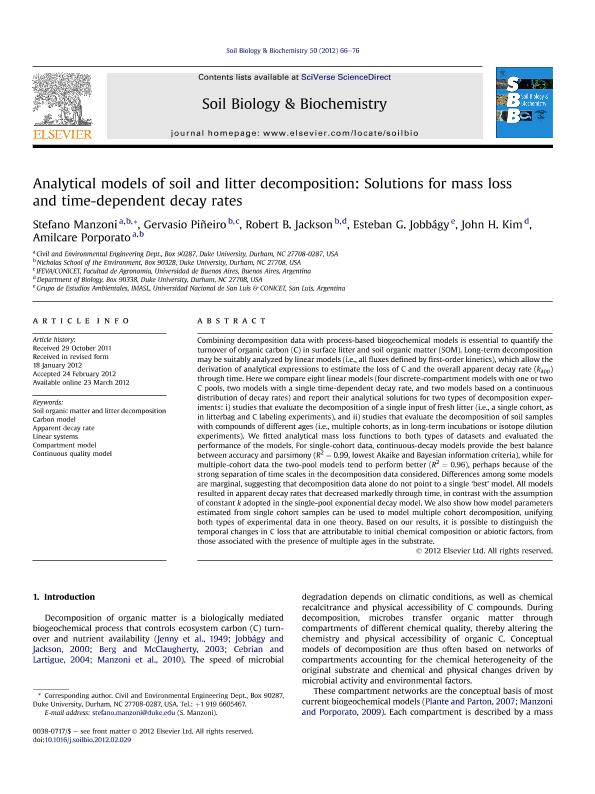Artículo
Analytical models of soil and litter decomposition: Solutions for mass loss and time-dependent decay rates
Manzoni, Stefano; Piñeiro, Gervasio ; Jackson, Robert B.; Jobbagy Gampel, Esteban Gabriel
; Jackson, Robert B.; Jobbagy Gampel, Esteban Gabriel ; Kim, John H.; Porporato, Amilcare
; Kim, John H.; Porporato, Amilcare
 ; Jackson, Robert B.; Jobbagy Gampel, Esteban Gabriel
; Jackson, Robert B.; Jobbagy Gampel, Esteban Gabriel ; Kim, John H.; Porporato, Amilcare
; Kim, John H.; Porporato, Amilcare
Fecha de publicación:
07/2012
Editorial:
Elsevier
Revista:
Soil Biology And Biochemistry
ISSN:
0038-0717
Idioma:
Inglés
Tipo de recurso:
Artículo publicado
Clasificación temática:
Resumen
Combining decomposition data with process-based biogeochemical models is essential to quantify the turnover of organic carbon (C) in surface litter and soil organic matter (SOM). Long-term decomposition may be suitably analyzed by linear models (i.e., all fluxes defined by first-order kinetics), which allow the derivation of analytical expressions to estimate the loss of C and the overall apparent decay rate (kapp) through time. Here we compare eight linear models (four discrete-compartment models with one or two C pools, two models with a single time-dependent decay rate, and two models based on a continuous distribution of decay rates) and report their analytical solutions for two types of decomposition experiments: i) studies that evaluate the decomposition of a single input of fresh litter (i.e., a single cohort, as in litterbag and C labeling experiments), and ii) studies that evaluate the decomposition of soil samples with compounds of different ages (i.e., multiple cohorts, as in long-term incubations or isotope dilution experiments). We fitted analytical mass loss functions to both types of datasets and evaluated the performance of the models. For single-cohort data, continuous-decay models provide the best balance between accuracy and parsimony (R2 ¼ 0.99, lowest Akaike and Bayesian information criteria), while for multiple-cohort data the two-pool models tend to perform better (R2 ¼ 0.96), perhaps because of the strong separation of time scales in the decomposition data considered. Differences among some models are marginal, suggesting that decomposition data alone do not point to a single ‘best’ model. All models resulted in apparent decay rates that decreased markedly through time, in contrast with the assumption of constant k adopted in the single-pool exponential decay model. We also show how model parameters estimated from single cohort samples can be used to model multiple cohort decomposition, unifying both types of experimental data in one theory. Based on our results, it is possible to distinguish the temporal changes in C loss that are attributable to initial chemical composition or abiotic factors, from those associated with the presence of multiple ages in the substrate.
Palabras clave:
Biogeochemistry
,
Organic Carbon
,
Decay Rate
,
Decomposition
Archivos asociados
Licencia
Identificadores
Colecciones
Articulos(IFEVA)
Articulos de INST.D/INV.FISIOLOGICAS Y ECO.VINCULADAS A L/AGRIC
Articulos de INST.D/INV.FISIOLOGICAS Y ECO.VINCULADAS A L/AGRIC
Articulos(IMASL)
Articulos de INST. DE MATEMATICA APLICADA DE SAN LUIS
Articulos de INST. DE MATEMATICA APLICADA DE SAN LUIS
Citación
Manzoni, Stefano; Piñeiro, Gervasio; Jackson, Robert B.; Jobbagy Gampel, Esteban Gabriel; Kim, John H.; et al.; Analytical models of soil and litter decomposition: Solutions for mass loss and time-dependent decay rates; Elsevier; Soil Biology And Biochemistry; 50; 7-2012; 66-76
Compartir
Altmétricas



